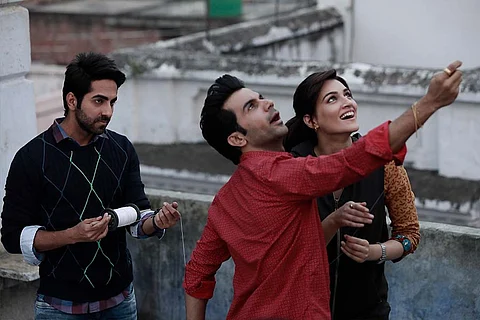
- Reviews
- Power List 2024
- Cannes 2024
- In-Depth Stories
- Web Stories
- News
- FC Lists
- Interviews
- Features
- FC SpecialsFC Specials

Bareilly Ki Barfi (2017) is a romantic comedy film directed by Ashwiny Iyer Tiwari. We all have our go-to movies, the ones that we eventually turn to after unsuccessfully scrolling through whatever streaming platform we are on. Well, BKB is one of those films for me. While the story is a classic love triangle, what interests me is how well the characters have been written. I could spend an hour reviewing this movie, but that is not the agenda of this article.
Have you noticed the rise in stories set in different parts of India, away from metropolitan cities? BKB, Gangs of Wasseypur (2012), Masaan (2015), and Badhaai Ho (2018), are just a few examples of such movies. It is not so much that these films are set in small towns, but the sensibilities of the characters are local too. In BKB, we see a worried father telling his daughter to sit with both legs on the side when she is sitting on a bike with a stranger. In Masaan, we could feel the inner conflict of a man who belongs to a family that cremates the dead to earn a living. What is heartening is that the stories are deeply rooted in that geography and it is not merely used as a plot device.
Local hearts, urban aspirations
There is a certain chasm between urban and local characters. In BKB, we see Bitti (Kriti Sanon) secretly taking a drag before she hands the cigarette to her dad. And we see Pritam (Rajkummar Rao) transform from a meek saree seller to a hip urban character with shades, with the song "Badass Babuaa" picturised for Rao's character. Bitti watches pirated Hollywood films, struggling to process the English subtitles. It is ironic that we, as an audience, find profundity in characters "yearning to be urban", but if an urban kid tries too hard, he would be instantly ridiculed. In Masaan, we see Deepak (Vicky Kaushal) studying hard in hopes of a better life in the city.
I have been a student of Vinit Masram's brilliant YouTube channel Cinema Beyond Entertainment. In his analysis of Rang De Basanti (2006), he talks about how Bollywood movies have repeatedly reflected India's sentiments. The poverty of the 60s was reflected in Guru Dutt's Pyaasa (1957), the song "Mera Joota Hai Japani" from Shree 420 (1955) echoed the fact that we had become a nation that hungered for imported goods, and Rang De Basanti mirrored the anti-corruption sentiments that the people harboured.
My take on the de-urbanization trend is an invitation to look at these hinterland stories more closely. It is an opportunity to understand the sentiments of those who migrate to concrete jungles, leaving behind a rich landscape of local heritage and culture. And Bollywood, I believe, has reinvigorated itself, thanks to stories from places that lie beyond the city lines.